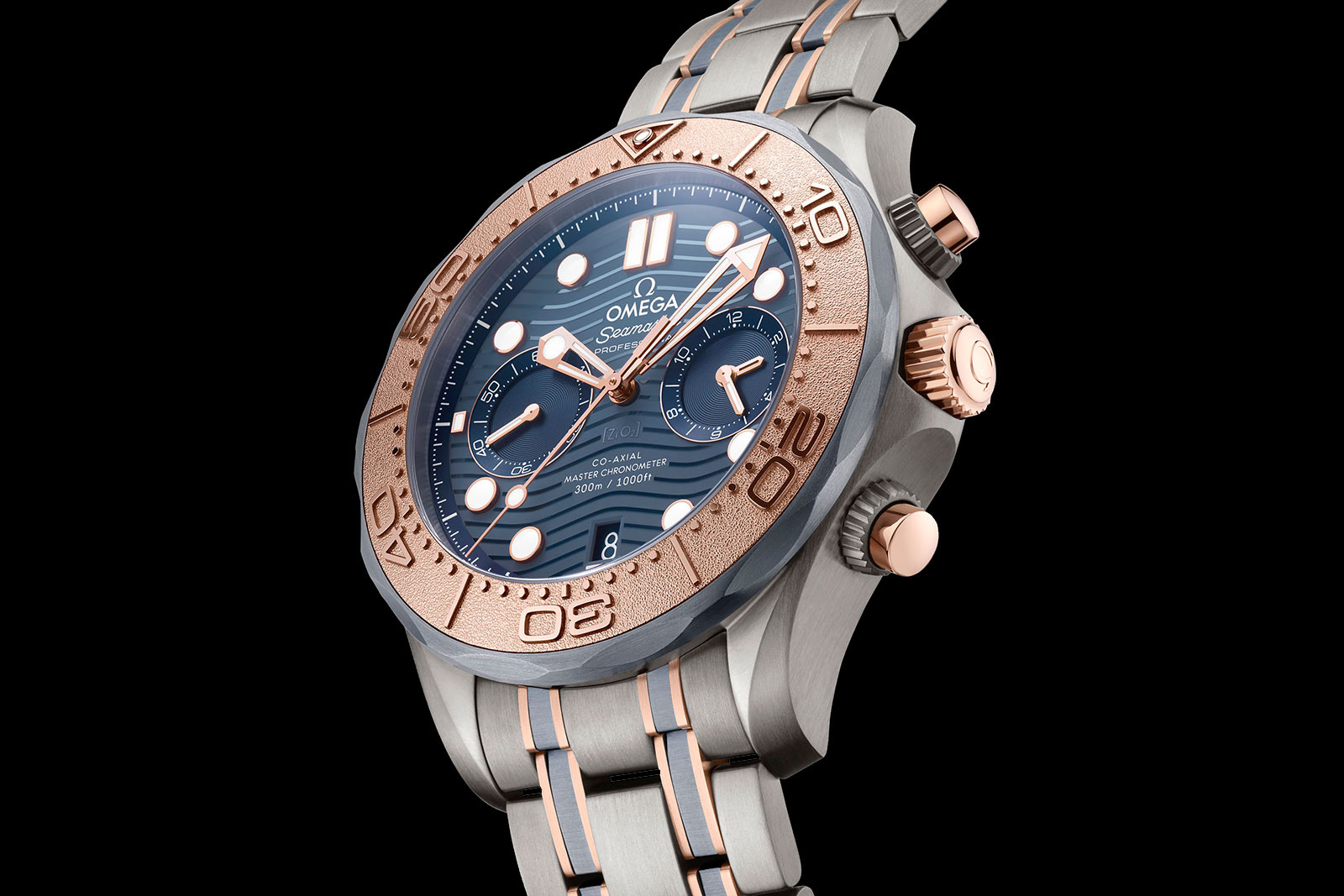Omega Introduces the Seamaster Diver 300 M Chronograph Gold Titanium Tantalum
Tri-metal fusion.
Best known as the watch worn by Pierce Brosnan playing James Bond, the Omega Seamaster Diver 300 M made its debut in 1993. But the blue-on-blue “Bond” model was not the flagship of the line. That distinction went to a chronograph composed of three metals – gold, titanium, and tantalum – an exotic and expensive combination two decades ago.
The tri-metal combination (the original was the ref. 2296.80 for anyone curious) made a comeback as a time-only watch for the 25th anniversary of the Seamaster 300 M two years ago. Now, Omega has finally revealed a truer homage to the original, the Seamaster Diver 300 M Chronograph Gold Titanium Tantalum, which stays to the aesthetics of its inspiration but refined to be more contemporary and technically advanced.
Initial thoughts
The original version of the tri-metal chronograph isn’t the best known variant of the Seamaster – because it was extremely expensive for the period and sold poorly – so when the time-only variant debuted in 2018, the combination of metal was rather novel. The new chronograph feels exactly like that – it is handsome and modern, but like the 1993 original, it is very expensive.
In fact, it is a lot more expensive, all things considered. Priced at a little under US$20,000, the new chronograph is significantly more expensive than its steel-and-gold counterparts – by a factor of 50%. While the price tag partially justified by the unusual material combination and good looks, the new Seamaster Chronograph is just too pricey.
The tri-tone
Though not as expensive as precious metals, tantalum is difficult to machine – it wears out tools as quickly as platinum – making it expensive to fabricate. So the metal is used sparingly on the watch, as it was on the 1993 original.
The bezel is tantalum, which complements the Sedna gold insert well. And like many of Omega’s higher-end dive watches, the insert is in relief, with polished, raised markings against a granular, frosted base.
The serial of each watch is engraved on a plate made of Sedna gold, Omega’s proprietary rose gold alloy that is resistant to fading
The tri-metal construction is most obvious on the bracelet. The innermost links are tantalum and flanked on each side by Sedna gold, with the largest components of the links being titanium. Side by side, the metals are distinct; the colour of tantalum stands out, emphasising its unusual blue hue.
As an aside, the pushers have knurled rings at the base, which are purely for show and a bit of an affectation. The pushers are not screw down, and already water resistant in themselves.
While the highlight is the contrasting metals of the case and bracelet, the dial is fancily executed. And it stands out – compared to the grey dial in the time-only variant, this dial is more striking and also possesses better contrast against the colours of the case.
Done in greyish blue, instead of the brighter blue of the standard Seamaster, the dial echos the unique colour of tantalum, a grey metal with a bluish tint. It’s made of ceramic that’s laser engraved with a wave pattern, while the hour markers and sub-dial rings are 18k Sedna gold.
High-spec mechanics
Powering the watch is the brand’s flagship cal. 9900, a massive upgrade over the Valjoux 7750 in the original. The cal. 9900 is kitted out with column wheel, vertical clutch, and silicon hairspring, plus chronometer certification from METAS, the Swiss meteorological authority that oversees Omega’s Master Chronometer testing.
The underside of the sapphire back is laser engraved with the Seamaster emblem, which is then filled in white lacquer
One of the more practical features of the watch is the time-zone function for the hour hand, which can be set in steps of an hour backwards or forwards, making it easy to change time zones when travelling.
This numbered edition comes in a box modelled on a pressure chamber
Key Facts and Price
Omega Seamaster Diver 300 M Chronograph Gold Titanium Tantalum
Ref. 210.60.44.51.03.001
Diameter: 44 mm
Height: Unavailable
Material: Titanium; bezel in tantalum; bezel insert, crown, and pushers in Sedna gold
Water resistance: 300 m
Dial: Blue ceramic
Movement: Cal. 9900
Functions: Hours, minutes, seconds, date, and chronograph
Winding: Automatic
Frequency: 28,800 beats per hour (4 hz)
Power reserve: 60 hours
Strap: Titanium bracelet with inner links in tantalum and Sedna gold
Limited edition: No, but sequentially numbered on side of the case
Availability: At Omega boutiques and authorised retailers from November 2020
Price: US$19,300; or 28,250 Singapore dollars
For more, visit omegawatches.com
Back to top.